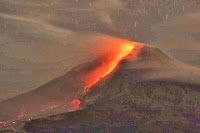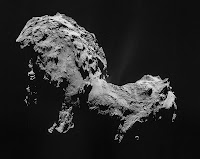10199 Chariklo is a Centuar (asteroid or comet-like body found between the orbits of Jupiter and Neptune), which was first discovered in 1997 and subsequently found to be the largest such body, with an estimated diameter of about 300 km. Like other Centaurs it is thought to have originally been a Kuiper Belt Object, i.e. a body orbiting outside Neptune, that was pushed further into the Solar System by an encounter with the planet. In 2014 10199 was discovered to have a system of rings, the first non-planetary mass object to have such a system, though a similar ring system has since been found around another Centaur, Chiron.
Pan and Wu calculate that 10199 Chariklo has an oblateness of 0.213 (i.e. its equatorial radius is 21.3% larger than its polar radius) and that its equatorial radius is 144.9 km. The body has two known rings, an inner ring with a radius of 390.6 km and a width that varies between 5.5 and 7.1 km, while the outer ring has a radius of 404.8 km and has a width of 3.6 km. Using these measurements combined with the optical depth of the rings (i.e. their transparency, the amount of light they absorb as it passes through them), Pan and Wu calculate that the rings have a total mass of about 10 billion tonnes.
Next Pan and Wu considered possible scenarios for the formation of the rings of 10199 Chariklo. In order to do this it was assumed that the average residency in a Centaur-type orbit is about five million years; Centaurs orbit in an area of the Solar System where they are perturbed by the gravitational influences of the giant planets, and ate therefore thought likely to be disrupted from these orbits in a relatively short time (astronomically speaking). Prior to becoming a Centaur 10199 Chariklo is assumed to have been a Kuiper Belt Object, orbiting outside the orbit of Neptune for about five billion years (i.e. the age of the Solar System). Furthermore Pan and Wu calculate that given the week gravitational pull of 10199 Chariklo, the rings should disperse to the point of no longer being visible within about 500 000 years of their formation, unless they are being constantly replenished from some source. This lifetime could be lengthened if the rings are accompanied by several
shepherding satellites (i.e. larger bodies orbiting 10199 Chariklo that
excerpt gravitational influences on the rings), however this would
require several kilometre sized objects, which are unlikely to have
remained undetected.
Firstly Pan and Wu examined the possibility that the rings might have originated while 10199 Chariklo was still within the Kuiper Belt. The most likely cause of ring-formation around a body in the Kuiper Belt would be a collision with a smaller body. Impact events are thought to be extremely rare in the Kuiper Belt (where matter is extremely thinly spread), but over the course of five billion years an object the size of 10199 Chariklo might be expected to undergo several such collisions. However the likelihood of such an event having happened within the last 500 000 years is extremely low, and the likelihood of our having observed two bodies (Chariklo and Chiron) with ring systems caused by collisions in the Kuiper Belt within the last 500 000 years is negligible.
An alternative scenario is that matter could have been removed from the surface of 10199 Chariklo by rotational disruption, however the body currently only rotates on its access roughly once every seven hours, not fast enough to cause such disruption, and there is no reason to believe that it would have rotated significantly faster within the last 500 000 years.
A third possible scenario is that the rings began as a small satellite orbiting 10199 Chariklo while it was in the Kuiper Belt, which was broken up by tidal forces during the encounter with Neptune that pushed it into a Centaur-type orbit. Such small moons are thought likely to be quite common around Kuiper Belt Objects, so this scenario has some plausibility, however in order for rings generated by such an encounter to survive, the object would have to be shifted from a Kuiper Belt orbit to a Centaur orbit in a single encounter with Neptune. Models of such processes suggest that most Kuiper Belt Objects take several close encounters with Neptune to disrupt them into the Solar System, with only a very small percentage being shifted in a single encounter. Again this is just about plausible for a single body, but the presence of two ringed Centaurs suggests that some other factor is at play.
As an alternative Pan and Wu suggest that the rings could be the result of dust being carried from the surface of the body during outgassing events. For the purpose of the study they model outgassing of carbon monoxide, but note that essentially the same processes could apply to outgassing of carbon dioxide, nitrogen, cyanide or other volatile compounds,
Carbon monoxide has a very low sublimation point (point at which it turns directly from a solid to a gas), so that it can be removed from a body even by the gentle warming the Sun provides in the Kuiper Belt. This means that a Kuiper Belt Object orbiting at about 20 AU (20 times as far from the Sun as the Earth) would have lost all of its carbon monoxide over the five billion year history if the Solar System. However a body at 40 AU would only have lost carbon monoxide down from its surface down to a depth of about 1 km, with more deeply buried carbon monoxide protected from the Sun's heat.
Were such a body moved into a Centaur-type orbit by an encounter with Neptune, then such buried carbon monoxide would be heated to above its sublimation point and degas into space, in the same way as comets (thought to be Kuiper Belt Objects knocked into the Inner Solar System) emit gas and dust to form a coma and tail as they approach the Sun. 10199 Chariklo currently orbits at an average distance of 15.8 AU, at which distance Pan and Wu calculate the body would be warmed through sufficiently for all carbon monoxide to be lost from its interior within 500 000 years. However the body has a highly eccentric orbit, varying from 13.1 to 18.5 AU over an orbital period of 22 915 days, sufficient to provoke distinct seasonality on the surface. This means that even though the interior of the body had warmed sufficiently for carbon monoxide to sublimate, temperature variations at the surface could lead to the gas resolidifying close to the surface during the 'winter' season when it is furthest from the Sun.

This seasonality could lead to a spring on 10199 Chariklo (possibly quite close to perihelion, when the body is at its nearest to the Sun), when the surface could reach a critical temperature and large quantities of accumulated subsurface carbon monoxide could degas over a very short period of time, carrying considerable volumes of dust from the surface. Even if the majority of this dust fell back to the surface a sufficient amount could reach an altitude high enough to remain in orbit to create at least a temporary orbit, creating at least a temporary ring system. Crucially such a series of events would slow down the rate at which carbon monoxide is lost from 10199 Chariklo, so that instead of a slow degasing over 500 000 years, a series of interrupted degasing events could go on for several million years.
See also...
Many
comets have been observed to have pitted surfaces. Initially these pits
were thought to be the result of collisions with smaller bodies, as
with craters on planets and moons, but they have been shown to be far to
numerous for this to be the case, as...
 Asteroid 2016 DB passes the Earth. Asteroid
2016 DB passed by the Earth at a distance of 123 900 km (0.32 times
the average distance between the Earth and the Moon, or 0.08% of
the average distance between the Earth and the Sun; 103 900 km above the
orbit at which the satellites supporting...
Asteroid 2016 DB passes the Earth. Asteroid
2016 DB passed by the Earth at a distance of 123 900 km (0.32 times
the average distance between the Earth and the Moon, or 0.08% of
the average distance between the Earth and the Sun; 103 900 km above the
orbit at which the satellites supporting... Fireball seen over southern France and northern Italy. A bright fireball was seen over much of southeast France and northern
Italy at about 6.20 pm local time on Wednesday 17...
Fireball seen over southern France and northern Italy. A bright fireball was seen over much of southeast France and northern
Italy at about 6.20 pm local time on Wednesday 17... Asteroid 2016 CG18 passes the Earth. Asteroid
2016 CG18 passed by the Earth at a distance of 151 400 km (0.39 times
the average distance between the Earth and the Moon, or 0.10% of
the average distance between the Earth and the Sun; 131 400 km above the
orbit at which the satellites...
Asteroid 2016 CG18 passes the Earth. Asteroid
2016 CG18 passed by the Earth at a distance of 151 400 km (0.39 times
the average distance between the Earth and the Moon, or 0.10% of
the average distance between the Earth and the Sun; 131 400 km above the
orbit at which the satellites...
































